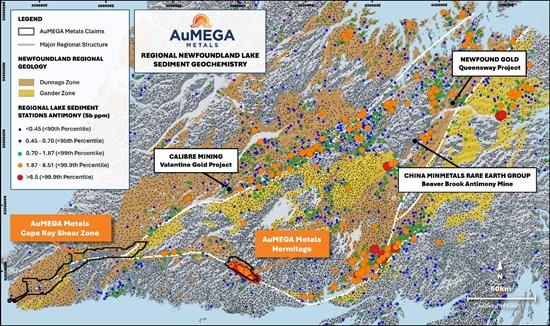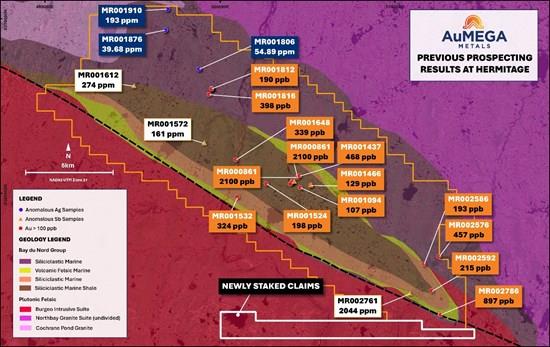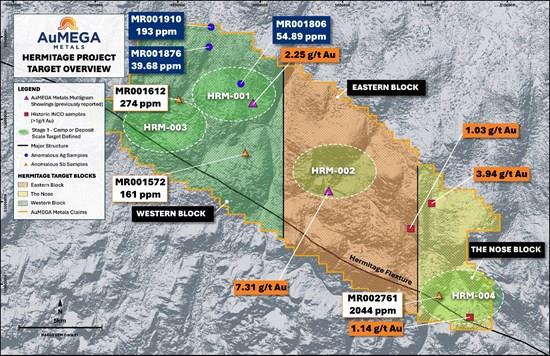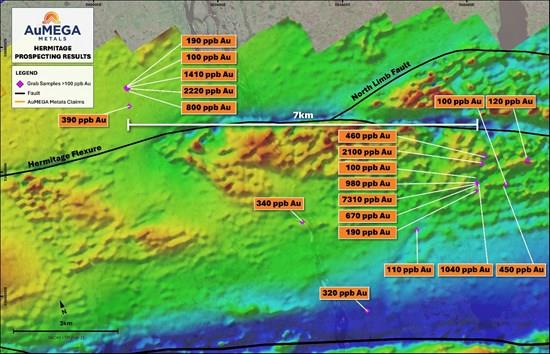(MENAFN- Newsfile Corp)
Key Highlights
Prospecting and mapping currently underway at the Hermitage Gold and Antimony Project. This recent prospecting work has identified several large areas of hydrothermal alteration that host quartz-dominated hydrothermal breccias with relatively chaotic hydrothermal breccias transitioning to breccia veins containing angular wall-rock clasts away from the fault strands1. Recent mapping and data analysis interprets the regional-scale North Limb Fault, previously identified by the Company, comprises of numerous subparallel fault splays and links that have potential to form a permeability network on a massive scale. High-resolution airborne magnetic and very low frequency ("VLF") geophysical survey expected is now expected in the Canadian autumn of 2024. Staked mineral licence2 adjacent to the south of the Company's Hermitage claims extend AuMEGA tenement holding along an interpreted major structural splay. Historic Government Lake sediment geochemical studies identified the Hermitage Project area as having the largest and highest tenor antimony anomaly in the province. Hermitage Project is in the same geological domain as the recently closed high-grade Beaver Brook Antimony mine that operated for approximately six years. Currently evaluating the potential of historically identified uranium showings in the Hermitage Project area. Phase one diamond drilling assays are expected in the near-term with phase two drilling currently underway.
Edmonton, Alberta--(Newsfile Corp. - September 4, 2024) - AuMEGA Metals Ltd (formerly Matador Mining Ltd) (ASX: AAM) (TSXV: AUM) (OTCQB: AUMMF) ("AuMEGA" or "the Company") is pleased to provide an update on its high-grade Hermitage gold and antimony project. The Hermitage project is located on the Hermitage Flexure, the second largest known gold structure in Newfoundland and the site of the largest antimony lake sediment anomaly in the province.
AuMEGA Metal's Managing Director and CEO, Sam Pazuki commented:
"Hermitage is one of several projects we have in our portfolio and among our top ranked exploration projects due to its structural and geological architecture. We believe this is highly prospective gold belt and prospecting work has already produced encouraging gold and antimony results over the last two years. This includes multi-gram gold in outcrop over 7 kilometres of strike and high-grade antimony from samples, supporting our belief in the discovery potential of the project. We continue to validate the highly prospective nature of the Hermitage property through our systematic and results driven reconnaissance approach to exploration.
"The Hermitage geology displays the key characteristics required to host a major gold-bearing mineral system. It has the largest and highest tenor antimony and arsenic lake sediment anomaly in Newfoundland, and our prospecting results have confirmed a close association of gold to these key pathfinder elements while also heightening the potential for discovery of a domestic supply of other critical metals including Antimony. This prominent chemical signature, as well as the fundamental geology of Hermitage, is geologically akin to tier one gold mines in the Bendigo Terrane in Victoria, Australia.
"Hermitage remains underexplored. With early stage prospecting activities validating the significant gold and antimony potential, we will continue to explore Hermitage in a systematic way based on high quality, informed geological interpretation and efficient field work. Comprehensive geological mapping and sampling in prospective areas already identified commenced earlier this summer. Following a delay due to contractor availability, we are also planning a high-resolution airborne magnetic and VLF survey to improve definition of the four major target areas we identified as part of our targeting workshop conducted in June 2024 led by world-renowned structural geologist Brett Davis and involvement from experienced B2Gold geologists. The ongoing work is designed to define specific areas for drill testing in 2025.
"Finally, we have staked a new mineral licence adjacent to our property to the south and specifically the Nose block of the Hermitage Project (Figure 3). In staking this ground, we have acquired additional ground on the major North Limb splay that we had previously identified. We interpret this splay as a major second order structure splaying off the Hermitage Flexure and a potential dilation zone critical in localising and trapping hydrothermal fluids into resulting gold deposits."

FIGURE 1: NEWFOUNDLAND REGIONAL LAKE SEDIMENT ANOMALIES SIZED ON ANTIMONY (SB PPM)
To view an enhanced version of this graphic, please visit:

FIGURE 2: HERMITAGE PROSPECTING RESULTS (2022-2023) & NEW LICENSE
To view an enhanced version of this graphic, please visit:
Regional Newfoundland Lake Sediment Geochemistry
The Hermitage Project is defined by a significant anomalous antimony geochemical signature derived from a lake sediment sampling program completed by the Government of Newfoundland and Labrador in the late 1980's. This anomalous antimony geochemical trend is relatively high in amplitude, with Hermitage hosting seven of the top ten lake sediment antimony values recorded on the island of Newfoundland. Accompanying this is the single highest anomaly assay in the dataset at 22.1 ppm Sb (Figure 1). At Hermitage, the antimony lake sediment geochemical signature is higher than the equivalent anomaly surrounding the inactive Beaver Brook Antimony Mine located 160 kilometres north in the same geological domain (Figure 1).
The antimony-arsenic-gold association of Hermitage is analogous to other notable turbidite hosted gold deposits, such as Fosterville in Victoria (Australia) and Newfound Gold's Queensway project on the same geological structure northeast of Hermitage.
Hermitage Overview
The Company's Hermitage property consists of 27 kilometres of continuous strike along the large crustal scale suture zone between the Dunnage and Gander zones, known as the Hermitage Flexure. Regionally, the Dunnage zone contains volcanic packages hosting turbidite sequences, which are considered regionally prospective for hosting gold deposits throughout Newfoundland, and globally in places such as the Bendigo Terrane in Victoria, Australia, including Agnico Eagle's prolific Fosterville gold mine, also in Victoria.
The main structural trend on the island of Newfoundland strikes approximately northeast - southwest, approximately perpendicular to the inferred direction of continental collision and terrane accretion. The only regional scale portion of rocks on the island that strike oblique to this structural orientation are in the Hermitage Flexure. The oblique orientation of the Hermitage Flexure would have sponsored accommodation of strike-slip movement along the structure creating both contractional and extensional sites, the latter of which allowed formation of sedimentary basins in which the Hermitage host rocks were deposited in. These structurally anomalous rocks have been subsequently deformed, faulted and folded, with local progressive dilation needed to form large scale orogenic gold deposits.
The Company's exploration activities have been spread over three distinct areas within the Hermitage property. These three distinct blocks are defined by unique geological characteristics along with specific pathfinder geochemistry and mineralisation styles. Each block hosts multigram bedrock gold showings that span much of the strike extent of the Hermitage property (Figure 3).

FIGURE 3: OVERVIEW OF THE HERMITAGE PROJECT DISPLAYING THE PROJECT'S TARGET BLOCKS AND KEY GOLD SHOWINGS
To view an enhanced version of this graphic, please visit:
Previous Prospecting Results
In the Canadian autumn of 2022, the Company launched its inaugural prospecting work at Hermitage. Due to the extensive glaciated cover at Hermitage, Company personnel traversed approximately 45 kilometres along a series of rivers cutting across the eastern side of the Hermitage property. The primary goal of these activities was the identification of outcropping evidence of hydrothermal gold-bearing systems within the incised rivers. Secondary to this, the Company sought to improve the understanding of the Hermitage terrane to allow for the adequate planning of future exploration programs.
Samples collected from this program were analysed for gold mineralisation, pathfinder elements and whole-rock geochemistry classification. Key highlights included the discovery of multiple sulphide-bearing quartz veins containing greater than 1 g/t gold over 400 metres of strike (Figure 2) with peak assays that included 7.31 g/t gold in sample MR0012523. This series of multigram gold showings was five kilometres along strike from a historic rock sample collected by INCO grading 1.03 g/t gold4.
During the 2023 prospecting campaign at Hermitage, the Company discovered a second significant gold occurrence in outcrop, seven kilometres northwest from the 2022's high-grade discovery. Peak gold in bedrock at this new showing was 2.15 g/t gold, with additional bedrock samples grading 1.39 g/t gold, 0.72 g/t gold and 0.43 g/t gold over 30 metres of strike5. Additionally, highly anomalous arsenic samples were identified proximal to this gold showing, with a peak value of 3.8% arsenic5, further strengthening the important association of gold and arsenic in these turbidite-hosted sequences. This newly discovered gold occurrence is in a different structural setting to the 2022 discovery, located approximately one-kilometre to the north of a regional-scale northwest-southeast trending shear zone named the North Limb Fault.
Detailed follow-up work was conducted along bedrock exposures proximal to the 7.31 g/t gold sample in outcrop identified from the 2022 reconnaissance campaign. This 400 metre across-strike zone of multigram gold in bedrock returned six samples greater than 100 ppb gold, with a peak gold value of 0.98 g/t gold (MR001430 - outcrop)5.
New Claim Staked
The Company has recently staked additional ground adjacent to the Nose Block of the Hermitage Project.6 This area expands the Company's ground over the North Limb Fault, an interpreted major structure splaying off the Hermitage Flexure.
The North Limb Fault appears to have structurally removed the northern expression of the Hermitage syncline, resulting in a sharp juxtaposition between the Bay du Nord turbidite sequences and higher-grade metamorphosed sediments of unknown origin. Crustal scale structures such as the Hermitage Flexure are considered instrumental in the migration of gold bearing hydrothermal fluids, while its subordinate splays, such as the North Limb Fault and other subsidiary structures, are generally critical in localising and trapping these fluids into resulting gold deposits.
In support of this, recent geological mapping traverses across the strike of the belt and along the North Limb Fault have identified abundant silica-dominated hydrothermal breccias and vein networks proximal to, and defining, the structure. The North Limb Fault is interpreted as a braided fault system, comprising numerous subparallel fault strands that have sponsored formation of a permeability network on a massive scale. This permeability network manifests as quartz-dominated breccia vein populations, vein stockworks and sheeted vein arrays defining the damaged rock within, and adjacent to, the fault strands. Importantly, sulphides and hydrothermal alteration in the form of sericite and chlorite, have been recently identified within these damage zones.
Tremendous gold prospectivity being enhanced on the Hermitage property with gold mineralisation in bedrock identified in two separate showings, proximal to the North Limb Fault seven kilometres apart along strike. This bedrock gold mineralisation is also hosted in two distinct geological units opening up prospectivity on both the hangingwall and footwall of this major structure.

FIGURE 4: HERMITAGE NORTH LIMB FAULT OVERLAYED WITH PROSPECTING RESULTS
To view an enhanced version of this graphic, please visit:
Uranium Potential
The Company has recently reviewed historic studies of the potential for uranium on and near the Hermitage Project area. The Province of Newfoundland and Labrador currently hosts major uranium projects. Over the course of the next several months, the Company will continue to evaluate and better understand the potential of uranium within the Hermitage property.
- ENDS -
This announcement has been authorised for release by the Company's Board of Directors.
To learn more about the Company, please visit , or contact:
MENAFN05092024004218003983ID1108638482